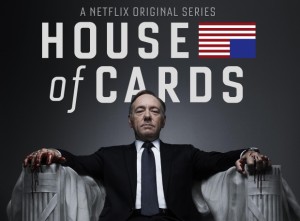Film subsidies trap Maryland taxpayers in ‘House of Cards’

FILM SUBSIDIES: Maryland and other states give millions of dollars each year to Hollywood.
By Kathryn Watson | Watchdog.org
ALEXANDRIA, Va. — Maryland politicians cast their film incentives program as the only way to lure productions like ‘House of Cards’ and boost the state’s economy.
Yet it could be that star-struck politicians and Hollywood producers are deceiving taxpayers just like the characters do in the popular fictional television show, which dramatizes the cunning trickery and cutthroat tactics of Washington, D.C.
From fiscal year 2012 to 2016, Maryland will have doled out $62.5 million in refundable tax credits for the film industry, with 96.5 percent of that total going to the production of two television series — ‘House of Cards’ and ‘VEEP.’ And yet, despite all of those breaks for Hollywood and claims of economic growth, a new study by the state’s legislative watchdog arm recommends the Maryland General Assembly allow for the subsidies to sunset in 2016.
Only time will tell whether Maryland’s Gov.-elect Larry Hogan will close the curtain on tax subsidies for Hollywood, or give a crutch to big business and push for their continuance.
“As soon as a film production ends, all positive economic impacts cease too,” the report from the Maryland Department of Legislative Services reads. “… Going forward, DLS recommends that the General Assembly focus economic development efforts on incentives that create permanent and lasting employment, rather than temporary jobs.”
The report brings just another blow to the subsidization of the film industry, a trend that gained rapid popularity with states in the 2000’s, but has leveled out and even declined slightly in some states as people become disenchanted with program results.
Maryland’s study just confirms what others have discovered nationally.
Studies on economic impact by the film industry oftentimes yield impressive results — but independent think tanks have revealed gloomier results. The median state analyzed by the Center for Budget and Policy Priorities received just 25 cents back in revenue for every dollar spent on Hollywood. Connecticut received just seven cents in revenue for every dollar it invested in its film subsidy program.
Bob Tannenwald, formerly a senior fellow for the Center for Budget and Policy Priorities who wrote the CBPP study in 2010, said the use of the subsidies — usually refundable tax credits — is just spending by another name.
“(Lawmakers) think they’ve found a golden goose in terms of job creation and income creation,” Tannenwald told Watchdog.org. “In fact, they’re something else that isn’t very effective and is taking money away from other needs — like education.”
Politicians may mean well, but the economic effects aren’t nearly as crystal clear as they’re often pictured, he said.
“The benefits of film production are visible and appear pretty quickly after a subsidy is implemented,” Tannenwald said. “But the costs are spread out over many elements of the state’s constituency. And they don’t all appear right away. They’re spread out over time as well as constituency. So they’re not as visible. As a result, particularly during a very severe recession and aftermath, the quick and visible benefits appeal to policy makers and the costs don’t appear to take as much bite as they actually do.”
Motivations for film subsidy programs, however, aren’t purely fiscal.
“And then there’s just the psychological (aspect), Tannenwald said. “People enjoy seeing superstars walking down the street and eating at a café.”
The arguments typically made by the film industry and state film offices are that films create jobs and stimulate the economy, but that isn’t necessarily the case.
Jobs created by the film industry are almost always temporary, Tannenwald said. Local actors participate for a short while, but then the jobs disappear. Local companies may be hired for security, but then the production crew moves on to another state.
Plus, the subsidies most benefit the high-paid actors and producers who hop from state to state, going wherever the subsidies lead.
Proponents of film subsidies say they have long-lasting impacts on boosting tourism. That may be true in some cases, Tannenwald said, but certainly isn’t a rule of thumb.
“My response to that is every film, whether it stimulates tourism or not, gets a subsidy,” Tannenwald said. “And if you just cherry-pick the ones that have a big effect on tourism you’re not looking at the whole financial picture.”
Tannenwald and others, like Tax Foundation Vice President Joe Henchman, argue that states are merely creating an unending arms race as they offer increasingly better subsidy packages. Because, as Tannenwald said, the film lobby is very aggressive, and even honest, they can easily pack up their things and move to a state with better incentives.
“The companies will be able to play states one against the other, forever,” Tannenwald said. He calls it, “perpetual competitive purgatory.”
Maryland’s own report pointed out, “film production entities ‘shop around’ for the most lucrative state film incentives.’”
“This type of competition is not only expensive, but promotes unhealthy competition among states,” the report said.
When ‘House of Cards’ producers threatened to cancel filming in Maryland if the state didn’t offer a generous package, state lawmakers fired back and threatened to use eminent domain laws to get their hands on the production company’s equipment. Some fiscally conservative governors like Susana Martinez in New Mexico have tried to rein in incentive programs.
It’s hard to picture the exact future of film subsidies, but Tannenwald thinks they’ll continue because of the never-ending competition among states.
There are just needs other than subsidizing Hollywood, he said.
“I just think a state can do better.”
— Kathryn Watson is an investigative reporter for Watchdog.org, and can be found on Twitter @kathrynw5.







